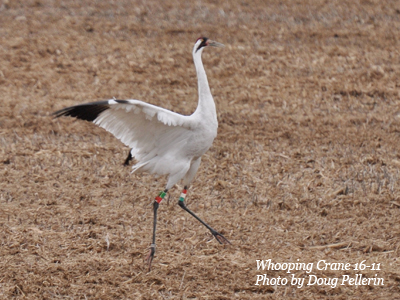Media Contact: Sara Gavney Moore, 608-356-9462 ext. 155
 Baraboo, Wis. (Oct. 11, 2016) – In a cross-country effort, experts from the International Crane Foundation (ICF) relocated a rare male Whooping Crane from the Horicon National Wildlife Refuge in Wisconsin to a breeding center in Florida. They believe the bird could play an important role in bringing his species back from the brink of extinction. Whooping Cranes are listed as endangered due in part to habitat loss and illegal hunting. As of today, only 600 of the cranes remain in North America – 163 of which are in human care.
Baraboo, Wis. (Oct. 11, 2016) – In a cross-country effort, experts from the International Crane Foundation (ICF) relocated a rare male Whooping Crane from the Horicon National Wildlife Refuge in Wisconsin to a breeding center in Florida. They believe the bird could play an important role in bringing his species back from the brink of extinction. Whooping Cranes are listed as endangered due in part to habitat loss and illegal hunting. As of today, only 600 of the cranes remain in North America – 163 of which are in human care.
Known by scientists as 16-11, the male Whooping Crane was reintroduced in Wisconsin in 2011, but gained notoriety last year for mating with a different species of crane, a Sandhill Crane, and helping to rear a hybrid chick that now resides at ICF’s crane center in Wisconsin. This unusual pairing demonstrates the few available breeding Whooping Crane partners in the wild. By successfully rearing the hybrid chick, 16-11’s fatherly nurturing skills have proven him to be critical in efforts to save his own species. Experts hope that by providing him a mate option of his own species, he will form a pair bond and be able to display the same paternal qualities and raise healthy Whooping Crane chicks to bolster the wild population in the eastern United States.
ICF safely caught 16-11 last week.
“If we had not secured him when we did, he soon would have migrated south to spend the winter with Sandhill Cranes,” said Richard Beilfuss, Ph.D., ICF president & CEO. “He is a valuable bird because of his excellent parenting skills, which are very important for this recovering population. This new pairing could provide a big boost for the future of his species.”
As researchers were securing 16-11, the female Sandhill Crane that 16-11 was seen with flew off with another Sandhill Crane. ICF’s research on Sandhill Cranes in central Wisconsin demonstrates that cranes re-pair quickly after losing a mate, and they are optimistic that the female will quickly form a bond with a Sandhill Crane male.
Meanwhile, 16-11 made a migration of his own, as ICF representatives drove him and his new potential mate – affectionately known as “Hemlock” – south to White Oak Conservation, a conservation center and breeding center for endangered species in Yulee, Fla. The facility provides the pair vast, open space in a remote natural environment. Missing the annual fall migration will not affect the two Whooping Cranes, but having time alone together at the White Oak Conservation facility could do a world of good in helping the pair develop a strong bond. If the two birds pair well, they will eventually be brought back to Wisconsin to join the existing flock, rear chicks in the wild and participate in future migrations.
This program is managed and monitored collaboratively by the Whooping Crane Eastern Partnership whose members include the International Crane Foundation, U.S. Fish and Wildlife Service, Patuxent Wildlife Research Center, Operation Migration, Wisconsin Department of Natural Resources, and other associated partners.
16-11 was originally hatched and raised in costume by ICF at its headquarters in Baraboo, Wis. and released at the Horicon refuge. The crane is one of many that the nonprofit annually rears and releases into natural habitats across the U.S. 16-11’s situation is a prime example of why experts at ICF continue to learn and refine their rearing and release strategies.
‘Hemlock’ was also hatched and reared at ICF and intended for release in 2012; however, she sustained an injury to her leg that required more time and rest to heal than could be provided prior to her first migration so she was brought back to ICF. She has since fully recovered and is the ideal age for pairing.
“Reintroduction of an animal into a natural habitat is challenging, and requires creativity,” said Beilfuss. “Our job is working until we find what works best, and we are dedicated to doing just that.”
###
About the International Crane Foundation
The International Crane Foundation plays a leading role in the conservation of Whooping Cranes, from managed breeding and release programs to habitat protection, citizen education and engagement, and threat reduction along their flyways. Learn more about the International Crane Foundation and its work to protect Endangered Whooping Cranes at www.savingcranes.org.
About the Whooping Crane Eastern Partnership
The Whooping Crane Eastern Partnership is a group of agencies, non-profit organizations and individuals, formed to restore to eastern North America, a migratory population of Whooping Cranes. More information about the partnership is available at www.bringbackthecranes.org.
